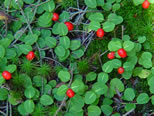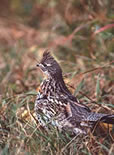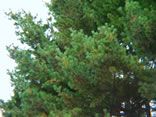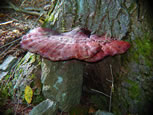
Nature Journal
| |
||
| Sunday, October 6, 2002 | ||
|
|
||
| This fungus is generally found | Click to enlarge | |
| on dead hemlock trees and stumps. | ||
| Saturday, October 5, 2002 | ||
| Hawk
migration is in full swing. Hawk
Mountain Sanctuary, in Eastern Pennsylvania, is widely known as
a prime hawk-watching site. Mid-October is the best time to see the
greatest variety of raptors at this location. At their website, you'll find the 2002 fall hawk count statistics and a list of the free weekend programs and daily nature talks that are available. You can also watch virtual tours (videos) of over ten hawk-watching areas at the Sanctuary. Some nice vistas! |
||
| Friday, October 4, 2002 | ||
 Here's
a picture of the tiny partridgeberry plant with ripe fruit. I found
it in the woods growing near some hemlock trees - along with four
different species of moss and lichen. Here's
a picture of the tiny partridgeberry plant with ripe fruit. I found
it in the woods growing near some hemlock trees - along with four
different species of moss and lichen. Each plant has two flowers which join to form a single berry in the fall. |
||
| Click to enlarge | ||
| Thursday, October 3, 2002 | ||
| Most
of the lance-leaved goldenrod has gone
to seed, but the New England
asters and the nodding ladies'
tresses are still blooming. There are also a few red clovers still
blooming. Since early morning I've been hearing the honking of the Canada geese as they migrate south. One flock after the other has been passing by - sometimes as often as 15 minutes apart. Went out to a more open area this afternoon and could see two flocks at the same time. It's early evening and I hear yet another flock coming now! Wonder why there are so many migrating on this day in particular. |
||
| Wednesday, October 2, 2002 | ||
 Have
been seeing a ruffed grouse quite
regularly on one of my usual walks. (Don't know if it is the same
individual bird each time.) Not realizing it's there, I walk
too close and startle it. Have
been seeing a ruffed grouse quite
regularly on one of my usual walks. (Don't know if it is the same
individual bird each time.) Not realizing it's there, I walk
too close and startle it.Then the whir of its wings, as it flies off, startles ME. Sometimes it flies across my path, but too quickly for me to get a good look at it. |
||
I occasionally see a female grouse with its young during the summer - and do have a better chance to observe them at that time. |
©
www.arttoday.com Click to enlarge |
|
The male doesn't participate in the nest-building activities or in caring for the young. So if you see an adult grouse with young in the summer, you can be pretty sure it's a female. |
||
| Tuesday, October 1, 2002 | ||
| Yesterday
I came across a small flock of black-capped
chickadees in the woods, along with a couple of white-breasted nuthatches. Nuthatches often flock together with chickadees as winter approaches. Other birds also join chickadee flocks, including tufted titmice, brown creepers, and downy woodpeckers. Above the sounds of the chickadees and nuthatches, I could hear the calls of the Canada geese on their way south. |
||
| Monday, September 30, 2002 | ||
 Like
deciduous trees lose their leaves, conifer trees also lose needles
in the fall. They become brown first, as can be seen in this close-up
photo of a white pine. Like
deciduous trees lose their leaves, conifer trees also lose needles
in the fall. They become brown first, as can be seen in this close-up
photo of a white pine.Of course, conifer trees don't lose all of their needles. Throughout the |
||
| year, about a third of their needles fall - and new ones take their place. | Click to enlarge | |
| Top of page | ||
|
|
| Birds | Butterflies | Mammals |
| Garden Shop |
New England:
Connecticut, Maine, Massachusetts, New Hampshire, Rhode Island, Vermont
